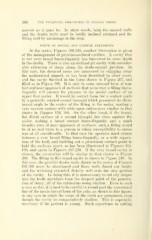Page 372 - My FlipBook
P. 372
166 THE TECHNICAL PROCEDURES IN FILLING TEETH.
narrow as it must be. In other words, both the enamel walls
and the dentin walls must be boldly inclined outward and the
filling held by anchorage in the step.
WIDTH OF BUCCAL AND LINGUAL EXTENSIONS.
In the series, Figures 206-210, another illustration is given
of the management of i3roximo-occlusal cavities. A cavitj' that
is not very broad bucco-lingually has burrowed to some depth
in the dentin. There is also an occlusal pit cavity with consider-
able extension of decay along the dento-enamel junction. In
this case, the decayed areas are uncovered by chipping away
the undermined enamel, as has been described in other cases,
and the cavity finished in the form shown in Figure 207, and
filled as in Figure 208. It is only in some unusual form of con-
tact and near api^roach of surfaces that so narrow a filling bucco-
lingually will answer the purpose in the mesial surface of an
upper first molar. It would be correct form for a contact made
by a partially rotated second bicuspid which presented its disto-
buccal angle to the center of the filling in the molar, making a
very narrow contact with wide open embrasures similar to that
shown in Figures 159, 160. On the other hand, if the broad,
flat distal surface of a second bicuspid lies close against the
molar, making a broad contact bucco-lingually and a much
broader area of near approach of surfaces, such a filling would
be of no real value to a person in whom susceptibility to caries
was at all considerable. In that case the operator must choose
between a very broad filling bucco-lingually, or a wide separa-
tion of the teeth and building out a prominent contact point to
hold the surfaces apart, as has been illustrated in Figures 155-
160, and again in Figures 217-220. If the very broad cavity is
chosen, the excavation will be similar to that shown in Figure
209. The filling in this broad cavity is shown in Figure 210. In
this case, the parallel dentin walls shown in the series of Figures
197-205 must be abandoned and these walls flared out boldly
and the widening extended distally well onto the step portion
of the cavity. In doing this, it is unnecessary to cut any deeper
into the tooth anj^where than the deepest point of the penetra-
tion of decay, all of the extensions being shallow. Even in such
a case as this, it is best to be careful to round ])ast tlie recessional
line of the mesio-buccal horn of the pulp, as shown in this figure,
in any case in which the cusps of the tooth are prominent, even
though the cavity be corai^aratively shallow. This is especially
necessary if the patient is young. Much experience in cutting


